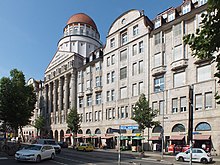Georg Wünschmann
Georg Wünschmann (born February 11, 1868 in Limbach ; † October 12, 1937 in Leipzig ) was a German architect .
Life

Wünschmann probably received his training from 1888 to 1890 at the Technical State Schools in Chemnitz . He was based in Leipzig from around 1891, where he moved into his own apartment at Nonnenstrasse 24 in 1893. After a few years as an employee in a larger architecture firm, he started his own business around 1895. The majority of his work was created before the First World War , and since the 1920s he has turned to the New Objectivity .
Wünschmann was married to the opera singer Theodora Franziska Serafine von Toula (born September 2, 1871 in Vienna), Theodor was born in 1901 and Werner in 1905. Through his wife, personal relationships arose with Austria, which also led to various construction projects in Carinthia .
In 1930, under the impact of the global economic crisis , Wünschmann retired from active professional life and left the Leipzig office to his son Werner Wünschmann. Georg Wünschmann was a member of the Leipzig scholars and artists' association The Leonids .
buildings
In Leipzig
- 1895/1896: Residential house, Am Lange Felde 15
- 1896/1897: Carl Förster house ("Rothenburger Erker"), Antonienstraße 1 / Altranstädter Straße 2
- 1896/1897: Villa Hagenguth, Uhlandstrasse 6
- 1897/1898: House, Chopinstrasse 16
- 1897/1898: residential building, Keilstrasse 4–6 (converted by Oscar Schade into the Brody synagogue in 1903/1904 )
- 1900: Carl Max Müller house, Kreuzstrasse 3
- 1901: Schreber - Hauschild monument, Aachener Strasse 7
- 1903: “Stately home” by the architect Georg Wünschmann, Scharnhorststrasse 2 / August-Bebel-Strasse 55
- 1904/1905: House, Chopinstraße 11a
- 1905: Villa Brehmer, Rudolph-Sack-Straße 7–9
- 1905: Villa Körnig, Prinz-Eugen-Straße 36–38
- 1905: Villa for the doctor Dr. Victor Rudolph, August-Bebel-Strasse 26
- 1905/1906: House, Bosestrasse 3
- 1906/1907: Paul Knaur office building, Auguste-Schmidt-Strasse 5–7
- 1907/1908: Villa “Sorabia”, meeting house for the Old Men’s Association of the Lausitzer Preacher Society (today Evangelical Student Congregation), Alfred-Kästner-Straße 11
- 1908/1909: "Wünschmanns Hof" office building, Dittrichring 18–20
- 1909/1910: "Stately home" for the builder Alfred Lohse, Fockestrasse 2
- 1909/1910: Villa Freytag, Schorlemmerstrasse 6
- 1913–1917: Palmengarten weir, Am Elster weir
- 1914: Undosa wave pool, old exhibition center
- 1914–1917: Administration building for the Association of German Handlers (LVB building until 2013, Wünschmann-Haus from 2015 ), Karl-Liebknecht-Straße 8-14
- 1915: Gravesite of the Paul Knaur family, Südfriedhof , Section VI / 2
- 1919: Tomb of the Georg Wünschmann family, Südfriedhof, Section VI / 3
- 1925: Reconstruction of the former club house of the Association of German Handlers , Harkortstraße 3
- 1926–1928: Housing complex for the non-profit building and settlement company “Heimat” (Berlin-Zehlendorf), Hildebrandstrasse 39a – 45c
- 1928: Klinger Bridge over the Elster flood bed , Käthe-Kollwitz-Straße
- 1928/1929: “Humanitas” home for frail children, Prager Straße 224
- 1928/1929: Administration building at Leipzig-Mockau Airport , Graf-Zeppelin-Ring 12
- 1929: Sample block of the building fair settlement, Hauffweg 1–5a
- 1929–1931: Housing complex for the non-profit building and settlement company “Heimat” (Berlin-Zehlendorf), Adolph-Menzel-Strasse 11–17a, Corinthstrasse 24–26, Walter-Cramer-Strasse 2–8
In other places
- 1897/1898: Kuzmany residential and commercial building in Velden am Wörther See (Austria), Am Korso 4
- 1898: House in Vienna (7th district), Kirchengasse 19 / Mondscheingasse 3
- 1899: Villa Gruhl in Brühl , Kaiserstraße 15
- 1903: Café Petersberg in Friesach (Austria), Wiener Strasse 2
- 1903–1907: Evangelical Four Evangelist Church in Arriach (Austria)
- 1904: Emil Bödemann double house in Taucha , Lindnerplatz 1 / Südstraße 5
- 1905: Conradi & Friedemann factory building in Limbach , Moritzstrasse / Weststrasse 4–6
- 1906: Factory building for the “Aristophot” photographic machine printing company in Taucha, Weststrasse 11
- 1925/1926: Hartmannbund doctors' home in Bad Berka , Am Ärzteheim
- 1926/1927: Children's sanatorium “Hermann-Hedrich-Heim” in Bad Frankenhausen / Kyffhäuser , Thomas-Müntzer-Straße
Individual evidence
- ↑ a b c d e f g Christoph Kühn; Brunhilde Rothbauer: Monuments in Saxony. City of Leipzig, vol. 1., southern urban expansion. (= Monument Topography Federal Republic of Germany ), Verlag für Bauwesen, Berlin 1998, ISBN 3-345-00628-6 .
- ^ A b Peter Leonhardt: Modernism in Leipzig. Architecture and urban development 1918 to 1933. Pro Leipzig, Leipzig 2007, ISBN 978-3-936508-29-1 .
- ↑ Bettina Weil: Leipziger Brücken II. City of Leipzig, Office for Statistics and Elections, Leipzig 2008, p. 49
literature
- Frank Zöllner (Ed.): Georg Wünschmann (1868–1937). A Leipzig architect and the plurality of styles. (= Leipzig contributions to art history , volume 1.) Passage-Verlag, Leipzig 2006, ISBN 3-938543-23-X .
Web links
- Literature by and about Georg Wünschmann in the catalog of the German National Library
- Georg Wünschmann. In: Architects Lexicon Vienna 1770–1945. Published by the Architekturzentrum Wien . Vienna 2007.
| personal data | |
|---|---|
| SURNAME | Wünschmann, Georg |
| BRIEF DESCRIPTION | German architect |
| DATE OF BIRTH | February 11, 1868 |
| PLACE OF BIRTH | Limbach (Limbach-Oberfrohna) |
| DATE OF DEATH | October 12, 1937 |
| Place of death | Leipzig |






